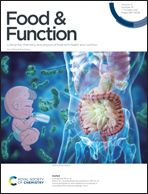Hepatoprotective effects of ginsenoside Rk3 in acetaminophen-induced liver injury in mice by activation of autophagy†
Abstract
Acetaminophen (APAP)-induced acute liver injury (AIALI) is one of the most common causes of acute liver failure. Owing to the limitations of N-acetylcysteine (NAC), which is the only antidote currently used in clinical practice for APAP, there is a need to develop new therapies that can provide extensive protection against AIALI. Ginsenoside Rk3 is a rare ginsenoside extracted from Panax notoginseng and a previous study has reported its excellent hepatoprotective function. In this study, we explored the therapeutic potential of ginsenoside Rk3 in APAP-induced acute liver injury. We found that ginsenoside Rk3 could reduce APAP-induced hepatotoxicity by reducing serum alanine aminotransferase and aspartate aminotransferase activity and pathological damage to the liver. Moreover, ginsenoside Rk3 could inhibit APAP-induced liver inflammation and oxidative stress by inhibiting the production of oxidative molecules, increasing the production of antioxidant molecules, and reducing the infiltration of inflammatory cells and the production of pro-inflammatory cytokines. Further mechanistic investigations revealed that the therapeutic effect of ginsenoside Rk3 was mainly dependent on the continuous activation of autophagy. Chloroquine, an autophagy inhibitor, was found to inhibit these protective effects. Therefore, ginsenoside Rk3 shows potential as a novel hepatoprotective agent to prevent drug-induced liver injury.



 Please wait while we load your content...
Please wait while we load your content...